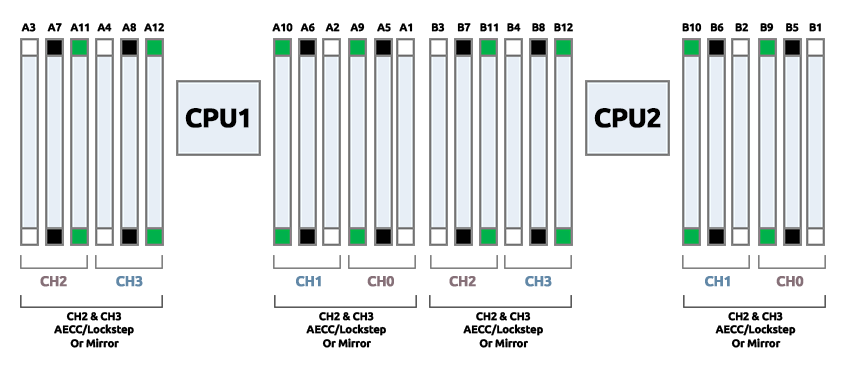The DELL PowerEdge R620 supports up to 768GB of memory, ensuring high performance across a range of applications. A large memory capacity means no compromises when leveraging the advantages of virtualization.
A total of 24 slots are available for memory upgrades, with 12 slots per CPU.
Memory can only be installed if the respective CPU is present.
Flexible memory configurations are supported from 4GB to 768GB, provided the following basic rules are adhered to during memory installation:

- Only one memory type is supported in the server, either RDIMM or LRDIMM
- Memory with x4 and x8 structures cannot be mixed. Therefore, we only offer x4 structured memory to avoid incompatibilities.
- A maximum of two different memory capacities (e.g., 16GB RDIMM and 32GB RDIMM) and a maximum of two different ranks (e.g., 2Rx4 and 4Rx4) can be used simultaneously in the PowerEdge R620. The memory modules with the highest capacity must be installed first.
- Each memory channel (CH0, CH1, CH2, and CH3) must be populated with at least one memory module, starting with the highest capacity and the highest rank number. A 32GB 4Rx4 memory should be installed before a 16GB 2Rx4 memory.
The memory slots are equipped with colored memory holders to simplify correct memory installation. The first DIMM slot is white, the second is black, and the third memory slot of a memory channel is marked green.
The installation order is explained on the system information sticker on the server’s chassis cover.
In a dual CPU configuration, the memory should be installed in the order A1, B1, A2, B2, etc. The different memory operating modes require different configurations:
Memory Optimized (Independent): {1, 2, 3, 4}, {5, 6, 7, 8}, {9, 10, 11, 12}
Advanced ECC (Lockstep / x8 SDDC) and Mirrored: {1+2, 3+4}, {5+6, 7+8}, {9+10, 11+12}
Quad Rank or UDIMM: {1, 2, 3, 4}, {5, 6, 7, 8}
Reliability, availability, and serviceability are important aspects demanded from the server and memory. DELL relies on the following RAS (Reliability, Availability, Serviceability) features:
Feature Description
Dense configuration optimized profile:
Increased memory reliability can result from this selectable platform profile that adjusts parameters to reduce faults regarding refresh rates, speed, temperature, and voltage.
Memory demand and patrol scrubbing:
Demand scrubbing is the ability to write corrected data back to the memory once a correctable error is detected on a read transaction. Patrol scrubbing proactively searches the system memory, repairing correctable errors.
Recovery from single DRAM device failure:
Recovery from Single DRAM Device Failure (SDDC) provides error checking and correction that protects against any single memory chip failure as well as multi-bit errors from any portion of a single memory chip.
Failed DIMM isolation:
This feature provides the ability to identify a specific failing DIMM channel pair, thereby enabling the user to replace only the failed DIMM pair.
Memory mirroring:
Memory mirroring is a method of keeping a duplicate (secondary or mirrored) copy of the contents of memory as a redundant backup for use if the primary memory fails. The mirrored copy of the memory is stored in memory of the same processor socket.
Memory address parity protection:
This feature provides the ability to detect transient errors on the address lines of the DDR channel.
Memory sparing (rank):
Memory sparing allocates one rank per channel as a spare. If excessive correctable errors occur in a rank or channel, it is moved to the spare area while the operating system is running to prevent the error from causing an uncorrectable failure.
Memory thermal throttling:
This feature helps to optimize power/performance and can also be used to prevent DIMMs from overheating.
We offer the following memory options for this DELL server:
8GB DDR3 RDIMM (ECC Registered) for sale
16GB DDR3 RDIMM (ECC Registered) for sale
32GB DDR3 RDIMM (ECC Registered) for sale
32GB DDR3 LRDIMM (ECC LR DIMM) for sale
